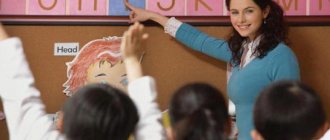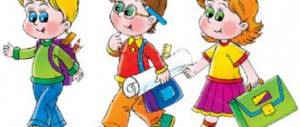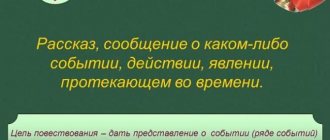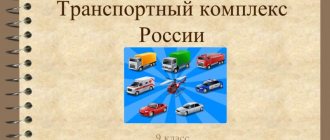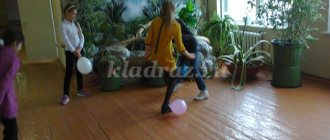Educational program for grades 1-4
Health group I – 6 people;
Health group II – 4 people;
III health group – 20 people.
Physical education group:
main – 24 people;
preparatory – 2 people.
There were no people exempted from physical education lessons due to health reasons.
Frequently ill students include …………..
Almost all students, except……. live on the territory of the village of Znamenka. All students in the class live in their own houses or their parents’ apartments; not a single family lives in rented apartments. Students are brought up in families in which parents pay attention and care to their children. They contain mutual understanding and respect between adults and children. Most children live in two-parent families, but there are children raised in single-parent families - ……..
The social and psychological microclimate in the classroom can be assessed as favorable. The nature of student relationships is friendly and respectful. In most situations, students are attentive to each other, caring, and friendly. All children understand the teacher and each other. In relationships between children, a sense of mutual assistance and understanding is developed. There is no clear leader in the class, and the existing microgroups are based on gaming and communicative interests, interests in extracurricular activities. There are no conflicts between these groups. Children recognize themselves as a single team, living according to their own laws, according to their own traditions. In general, the children developed a kind, positive attitude towards school, school staff, and teachers. The relationship between boys and girls is smooth and trusting. I believe that the level of cohesion among the class team has increased significantly over the past year. Each student in the class has a collective assignment, which they successfully complete. There is a class asset that involves the entire team in extracurricular and extracurricular activities. Various events, conversations, games, and celebrations of classmates’ birthdays contributed to the team’s unity. The prevailing desire in the class is to work together, help each other, be friends, already have someone to rely on - an asset of the class.
Academic achievement class is above average. The majority of children in the class learn willingly and easily, acquire solid knowledge of subjects, and conscientiously approach their studies and work. Some children require constant monitoring of educational activities by teachers and parents. Individual conversations are held with these children, and close communication is maintained with their parents. Children are active in lessons, fulfill all the teacher’s requirements, both in class activities and extracurricular activities. The class is efficient, accustomed to organizing a lesson. Pupils are familiar with school responsibilities and have adapted well to school life.
Educational work plan for the 5th grade class teacher
EDUCATIONAL WORK PLAN
Author: Class teacher of MBOU secondary school No. 5 in Vyazniki Lavrentyeva Irina Valerievna
Class characteristics.
This cool team began to form in 2009. Up to the fifth grade there were 25 people. The number of students in grade 5: 14 girls and 11 boys aged 11 years. The physical and mental development of students corresponds to the norm.
The students in the class are quite efficient. The class has an active group, shows great interest in public affairs, carries out public assignments, and is conscientious about classroom and extracurricular activities. The class is large in size, so there are groups based on interests, but in general the students have a positive attitude towards each other and are ready to help.
Children live in different neighborhoods of the city, so it is difficult for them to communicate after school. However, children living nearby in the same area spend time together after school, or attend classes together at an art school, where they study in the art department - 6 people, in the English department - 2 people, and two each in music, choreography and folklore departments.
Boys and girls are friends with each other, with the exception of student A., who almost every day becomes the object of hostility from other students in the class and school.
Schoolchildren experience the successes and failures of their class and root for their team. When holding social events, they try to stay together.
Class organization: Students are only at the stage of forming a class team and a class asset, therefore they do not yet have the skills to carry out collective tasks, distribute work among themselves and carry it out in the most rational way. Students do not yet know how to patiently and carefully listen to each other at class meetings, during recess , when performing various tasks. However, the orders of authorized persons are obeyed.
Communication between the class team and the school community:
Students in the class are always informed about what is happening in the school as a whole and in other classes. General school assignments (permanent and occasional) are always carried out. The class always actively participates in school-wide events. All children in the class are involved in extracurricular and extracurricular activities, take part in school events, attend clubs and sections taking into account their interests.
Students have a sufficient level of development of cognitive activity and learning motivation. Schoolchildren have a positive attitude towards studying, realizing the importance of studying in later life. The level of efficiency, activity, and independence of students in educational and extracurricular activities corresponds to the norm. Most students conscientiously complete homework, creative projects on ethics, history, often choosing a form of joint work for this. Students M. (in all core subjects) and A. (in English and mathematics) experience the most difficulties in their studies.
Plan of educational work in 5th grade for the school year
Plan of educational work with grade 5 “B” (with calendar and thematic planning).
Author: Tatyana Konstantinovna Vasilchenko, music teacher of MKOU Ramonskaya secondary school No. 2, Voronezh region, Ramonsky district, VNIISS village. Description: calendar and thematic planning of educational work with the class teacher. The material is useful for teachers, head teachers for educational work, and parents. Working at the Municipal Municipal Educational Institution Ramonskaya Secondary School No. 2 as a teacher, I organize, coordinate and conduct extracurricular educational work in the class assigned to me in 5b. Acting as a class teacher, I am guided by the educational goals and objectives facing the school. Goal: Formation and development of personality qualities on the basis of moral and civil-patriotic values through an active attitude towards the surrounding world, towards people, towards oneself, aimed at the formation of an active life position. Objectives: 1. Preservation, dissemination and development of national culture, fostering a caring attitude towards the historical and cultural heritage of one’s region; 2. Formation of the individual’s readiness and ability to fulfill a system of social roles. To implement the assigned tasks, priority areas were identified through which educational work was carried out: Civic-patriotic; Spiritual and moral; Family; Self management; Work of class teachers; Additional education. The effectiveness of the work of a class teacher is currently determined by the extent to which the educational process ensures the development of the creative abilities of each child, forms a creative personality and prepares her for creative, cognitive and social work activities. If these are the demands of modern society, then I should strive to realize in my activities one of the most important goals - nurturing the creative personality of a child. I set a goal: through extracurricular activities, to develop and educate the child’s personality, capable of independent creative activity, and to form a friendly class team. I work closely with additional education teachers: a children's and youth sports school, an art school, an orphanage for creativity, and a youth station. All children enjoy attending additional education clubs. My class takes an active part in school and regional competitions. The class teacher's documents include: 1. Annual plan of educational work. 2. Keeping a class journal. 3. Information about parents. 4. Keeping minutes of parent meetings. 5. Diagnostics. 6. Keeping logs on safety precautions and traffic rules. 7. Information about student attendance. 8. Working with an electronic journal. 9. Information about extracurricular activities. 10. Personal files of students. 11. Reports on educational work. 12. Application from parents and students for module classes. 13. Applications for transportation of students by school bus. A form of planning educational work is the arrangement of the content of promising activities in the classroom in calendar order. The calendar plan is as follows: Time, content of work, individual work, work with parents, notes. The form of planning is that all educational activities are reduced to a calendar and the plan is similar to a list of activities of the class teacher, arranged in chronological order. Table. Having analyzed my teaching activities, I have drawn conclusions about the appropriateness of the approaches to teaching forms, methods and techniques I use.
Work forces you to constantly search for forms and methods of learning. I believe that there are no limits to self-education, and the boundaries only expand over time, since modernity is very dynamic. The class teacher today is a developing and thinking teacher. He is able to positively influence students, mold souls and educate. Download Educational Work Plan
We recommend watching:
Adaptation of fifth-graders to the learning process in primary school Plan of educational work in 9th grade for the year Extra-curricular activity “Glory to the bread on the table”, 5th grade Report of the 5th grade class teacher for the first half of the year
Similar articles:
Adaptation of junior schoolchildren to secondary education
Features of the work of a class teacher in 5th grade
Adaptation exercises for fifth graders
To help the class teacher of grades 5-6
To help the 5th grade class teacher
Program of educational work of the class teacher (grades 1–4) “Our class is a friendly family.”
educating students in matters of physical education and personal hygiene;
formation of a mechanism of physical self-education, stimulation of self-education of will, endurance, perseverance, self-discipline;
diversified development of specific sports skills and mastery;
development of professionally significant physical qualities that ensure increased performance, stability of the nervous system, and the appearance of good health;
individual work with physically gifted children, taking into account their interests and inclinations.
Third direction:
spiritual and moral activity
To those who have not comprehended the science of good,
any other science only brings harm.
Michel de Montaigne
The highest wisdom is to distinguish between good and evil.
Socrates
The purpose of the work is to help students understand moral norms and rules.
Tasks:
to form in students a moral attitude towards people around them;
to form in students an awareness of the value of human life;
Formation of a system of value orientations of students as the basis of their education;
Cultivating a good attitude towards life, the ability to find joy in it and the desire to do good; formation of a moral attitude towards man, work, nature;
Activities:
development of the desire to act in accordance with acquired moral knowledge in real life situations;
development of the student’s strong-willed qualities, the ability to critically reflect on their strengths and weaknesses;
developing the ability to fight and survive in extreme situations;
introducing students to examples of the moral position of other people and their ability to survive in difficult life situations;
nurturing students’ interest in themselves, the desire for self-improvement;
formation of a positive attitude towards the customs and traditions of one’s family, one’s people, the ability to listen and hear, look and see, realize and draw conclusions.
Contents of moral education:
moral education - the formation of consciousness, moral feelings and skills of moral behavior;
ethical education - the formation of rules of good manners, a culture of behavior and relationships;
patriotic education - the formation of a sense of love and responsibility for one’s Motherland, readiness to defend the Motherland and one’s people;
formation of a sense of one’s own national dignity and respect for other nations and peoples;
political education - the formation of political consciousness. In turn, each of these areas includes:
the formation of a person’s spiritual principles, his desire to understand himself and his place on earth and in space;
moral education in matters of morality, ethics, politics (morality is a set of rules, norms of behavior of people, their responsibilities towards themselves, other people, society; criteria for distinguishing between evil and good, good and bad, worthy and shameful);
Goals and objectives of educational work 5th grade
The purpose of the educational work of the school :
- creating favorable conditions for a spiritually - moral, creative, active, developing, healthy individual, capable of successful socialization in society, competitiveness and active adaptation in the labor market.
The purpose of educational work in the classroom:
- adaptation of fifth-graders to new educational conditions, creation of the most favorable conditions for the development and development of each child;
- unification of the class team.
Tasks:
- creating conditions for preserving and strengthening the health of schoolchildren, promoting a healthy lifestyle;
- fostering conscious discipline and a responsible attitude to learning;
- formation of behavioral culture skills;
- fostering a conscientious attitude to work, developing the ability to work collectively;
- education of aesthetic culture, development of artistic abilities of students;
- involving parents in active participation in the life of the class;
- education of universal human and moral values, including a positive attitude towards life;
- maintaining and strengthening school traditions that contribute to the creation and strengthening of the school community;
- the formation of a legal culture, pride in national history, instilling respect for national culture, one’s people, one’s language, customs and traditions of one’s country.
CLASS EVENTS
Development of positive motivation for work and communication in the classroom;
Development of intellectual, creative, organizational abilities in children;
Development of ingenuity, creative imagination, the ability to quickly navigate the environment, and engage in teamwork.
September
2
Event “It’s not a shame to be kind.”
Dedicated to the Day of the Elderly
To promote kindness, politeness and mercy;
Identify the right and wrong ideas about kindness and good deeds.
October
3
"Autumn Birthday Day"
Fostering a sense of beautiful, caring attitude towards the world around us;
Developing positive motivation for work and communication in the classroom.
November
4
"Winter Birthday Day"
Development of intellectual, creative, organizational abilities in children;
Development of ingenuity, creative imagination, the ability to quickly navigate the environment, and engage in teamwork.
December
5
Sports festival “Our army is dear!”
Dedicated to Defender of the Fatherland Day
Develop a sense of patriotism and pride in our army. To instill in children a love for the Motherland, to evoke a desire to defend it.
February
6
Sports festival “Go, sports girls!”
Dedicated to International Women's Day
Strengthening the health of the younger generation, involving them in systematic physical education and sports; Promotion of healthy lifestyle;
Fostering a sense of collectivism and mutual assistance.
March
7
"The feat of Yuri Gagarin." Dedicated to Cosmonautics Day
Expand students' knowledge about science such as astronautics;
To develop students’ horizons, their creativity, ingenuity, and dexterity.
April
8
"Spring Birthday Day"
Formation of a class team.
May
Predicted result
As a result of educational work according to this plan, students should:
- acquire skills of cultural behavior at school, on the street, at home;
- master the curriculum of 5th grade educational activities;
- adapt to new educational conditions;
- develop the skills of a conscientious attitude towards work, including collective work;
- become a disciplined, active, creative student.
There are 6 main target areas:
- cultural, aesthetic, political growth of personality.
- Humanism and collectivism as positions characterizing a child in his attitude towards people. Comprehensive human development, covering intellectual, moral,
- Attitude to work, which is an indicator of human essence.
- Love for beauty and the need to communicate with beauty.
- Devotion to the Motherland and pride in it, regardless of economic and political difficulties.
- Physical education and hygienic culture.
Individual work with students
Maintaining interest in learning.
Ensure that every student feels comfortable in the school environment.
Helping students achieve a high level of organization.
Developing self-esteem for every child.
2. Monitoring student progress.
3. Constant monitoring and conversations with restless students, support for capable but not hardworking students.
4. Individual approach and assistance in studying to each student.
Interaction with the teaching staff
- Visiting teachers - colleagues teaching in this class.
- Conduct an analysis of the educational activities of the class and individual students together with subject teachers.
- Invite teachers to every parent-teacher meeting to coordinate the efforts of the family and school.
- Finding out from subject teachers the reasons for the decline in the performance of a particular child.
